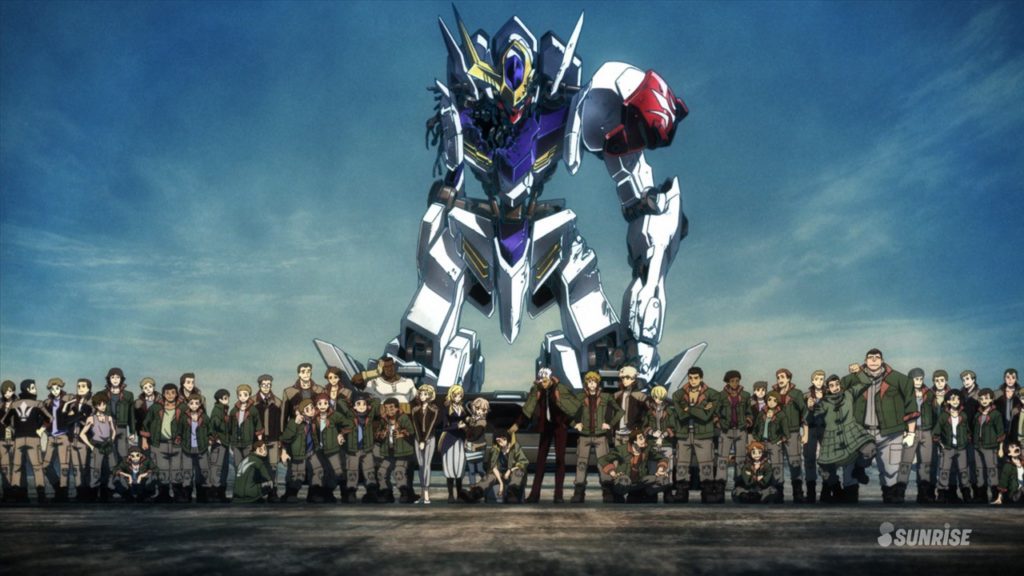War is a constant in the Mobile Suit Gundam multiverse. And it’s always children who are doing the fighting. While most of the series in the franchise’s history put teenagers on the front lines of these conflicts, risking life and limb for sometimes-nebulous causes, those rarely lingered on that issue. That changed with the 2015 release of Mobile Suit Gundam: Iron-Blooded Orphans, which put that bloody conflict front and center.
War Is for Losers is a meditation on Mobile Suit Gundam.
Iron-Blooded Orphans follows the exploits of a mercenary group known as Tekkadan, which is comprised entirely (with the exception of a small handful of support members) of boys under 18 years old. The series gives a reason for this, too: they have all been augmented with the Alaya-Vijnana system, which allows a direct neural interface between pilot and mecha. Getting the Alaya-Vijnana implanted requires invasive, dangerous surgery, and has to be done to children to allow the technology to grow with their nervous system. Adults can’t have the procedure, and it was forced upon all the boys of Tekkadan.
Nearly all of the children drafted into Tekkadan are orphans. The show even has a derogatory term for them: “human debris.” They’re treated by adults in power as subhuman, and they only get their own agency when they seize the mercenary company for themselves through murder. But even then, they are at the whims of those with more power.
The theme of adults abusing children is prominent in Iron-Blooded Orphans, and it’s often children being abused by people they thought they could trust. When she was barely 10 years old, one character fled from near-slavery working as a cleaner at a brothel, where she was beaten, slept on the floor and was starved as punishment. Another was betrayed, more than once, by a man she thought of as a mentor and benefactor. Her own father even tried to have her kidnapped.
War is hell, and Iron-Blooded Orphans shows the toll fighting takes on the children, both physically and emotionally. Many of them die, often in horrible ways. No characters are safe, and sometimes lay down their lives in vain. They also have to deal with the ramifications of many of their friends being killed in battle. It’s not an easy thing for the characters to grapple with.
Iron-Blooded Orphans doesn’t shy away from the violence its main characters perpetrate, either. Unlike many other Gundam shows, viewers often see pilots die. Cockpits in these mobile suits are targets for other pilots, and are routinely pierced by projectile shots or caved in by massive blows. Teenagers, as well as their adult opponents, die horribly in these tombs, crushed and bleeding out after being impaled by shrapnel or pierced by massive, mecha-sized melee weapons.
The series’ main character, Mikazuki Augus, is an emotionless killer. He is Tekkadan’s ace pilot and executioner. He tears through the battlefield, killing anyone who gets in his way, often to the shock and horror of his opponents. He gets more brutal as the series goes on, at one point ripping out an opponent’s cockpit and crushing it in his Gundam’s hand. He is a monster. But violence is all he has known his whole life.
The violence carried out by Tekkadan is a mirror of the violence they suffered. They were abused their entire lives by adults who were supposed to watch out for them. And when finally free of their control, they fall back to what they know best: violence.
No matter the series, Gundam has always been a show about fighting wars inside giant robots. Practically every series has had a high body count, but like the Star Wars series (which the Gundam franchise has often been compared to), the series’ approach toward grunt casualties mostly treats them as faceless, bloodless drones. Death in battle may matter, but unless you’re a named character, it’s rarely explicit. Mobile suits explode on the battlefield, and rarely has thought been given to the people piloting them.
But many times, death is the centerpiece of Iron-Blooded Orphans. Over and over, it explicitly shows the price that piloting a mobile suit carries, and how the same person can be both the perpetrator of violence and a victim of it.
Every Gundam war has a price. Iron-Blooded Orphans is just the first series to really show what it is.
Thanks for reading The Dot and Line, where we talk about animation of all kinds. Don’t forget to follow us on Twitter and sign up for our newsletter.
